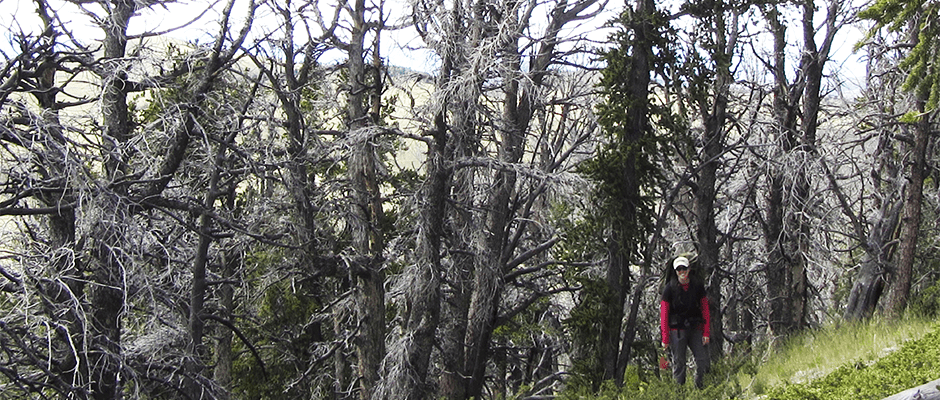Share this article
Ancient trees resist beetle epidemic
As the climate warms, a deadly scourge is spreading through North American pine forests: the mountain pine beetle (Dendroctonus ponderosae). But the beetles aren’t killing every type of pine in their path, according to new research. Great basin bristlecone pines (Pinus longaeva), the world’s longest living non-clonal organisms, appear to be immune to the beetles invading their high-altitude habitats.
“We probably looked at 3,000 to 4,000 trees across the summer. And we found no Great Basin bristlecones that were killed by mountain pine beetle, but many limber [pines] that were killed,” said Barbara Bentz, a research entomologist with the U.S. Forest Service Rocky Mountain Research Station and first author of a recent study in New Phytologist.
Mountain pine beetles have long coexisted with pine trees in North American forests, usually limiting their attacks to trees that are weak or stressed. But drought conditions can make whole forests vulnerable, and warming temperatures are allowing the beetles to spread into new habitats, including high elevations that used to be too cold for them. Recently, climate-related beetle epidemics have struck millions of acres of forest in Canada and the United States.
Previous studies have found that some high-elevation pine species are more vulnerable to mountain pine beetles than their low-elevation counterparts, presumably because they didn’t evolve with the pine beetle threat. For the new study, the researchers investigated the defenses of two additional high-elevation species, the Great Basin bristlecone pine and the foxtail pine (Pinus balfouriana). These species are closely related, with bristlecones native to the Great Basin and foxtail pines living further west in California. Both grow in mixed forests with limber pines, a species often attacked by mountain pine beetles.
First, the researchers selected bristlecone and foxtail habitats with known beetle outbreaks, using data from past aerial surveys. At sites spread across ten mountain ranges, the researchers established a series of survey plots, then examined every mature pine tree inside them.
Not one of the more than 1,100 bristlecone pines in the study had been killed by mountain pine beetles. Some bristlecones had a few of the beetles’ distinctive burrows under their bark, but the insects apparently weren’t able to overwhelm the trees, says Bentz. About 1.2 percent of foxtail pines in the researchers’ plots had been killed, suggesting that foxtails are partially resistant. In contrast, limber pines were much more vulnerable, with 17 percent dying from beetle attacks.
To find out why some pines resisted attacks while others succumbed, the researchers analyzed tissue samples from all three species, measuring the density of the wood and the levels of a sticky substance called resin. Resin helps trees defend against insects, both by flushing the invaders out and by exposing them to toxins.
As expected, bristlecones had the densest wood, and they produced the most resin — almost eight times as much as the vulnerable limber pines. Foxtail pines were in between the other two species, both in wood density and resin production.
The researchers aren’t sure why bristlecones and foxtail pines have such robust defenses, but they think it may have something to do with the trees’ extraordinarily long lives. Bristlecone pines can live for up to 5,000 years, while foxtail pines live for up to 3,400, says Bentz. It’s possible that the trees evolved with mountain pine beetles in the ancient past, and haven’t had enough time to lose their defenses. Alternatively, the dense wood and copious resin may not have originated as beetle defenses at all, instead evolving to help pines withstand millennia in harsh environments. In that case, the trees would later have co-opted their dense wood and resin to repel beetles.
Either way, says Bentz, the findings emphasize the importance of studying climate change impacts on a detailed level, with attention to evolutionary relationships.
“It shows that predicting what’s going to happen in a changing climate can be complex,” she said. “You can’t just say, ‘oh because it’s doing it in this species, it must be doing it in this host tree species as well.’”
Header Image: A researcher stands next to a Great Basin bristlecone pine that has survived a mountain pine beetle epidemic in the Snake Mountains, Nev. Around them, limber pines killed by the beetles are gray and skeletal. ©Barbara Bentz








